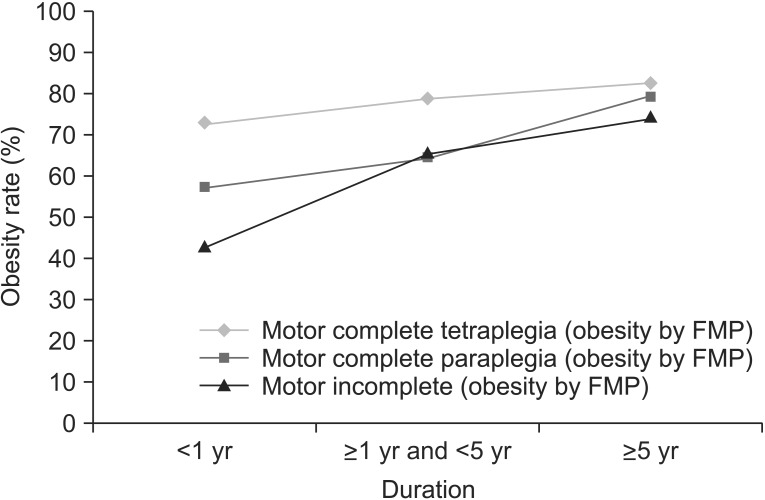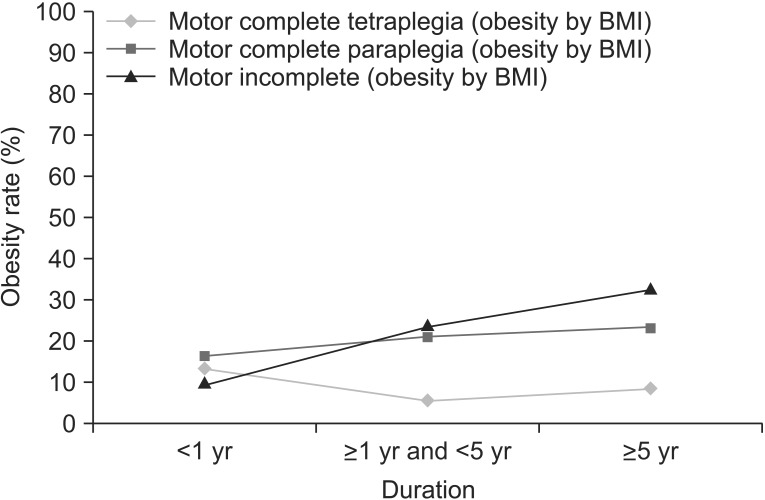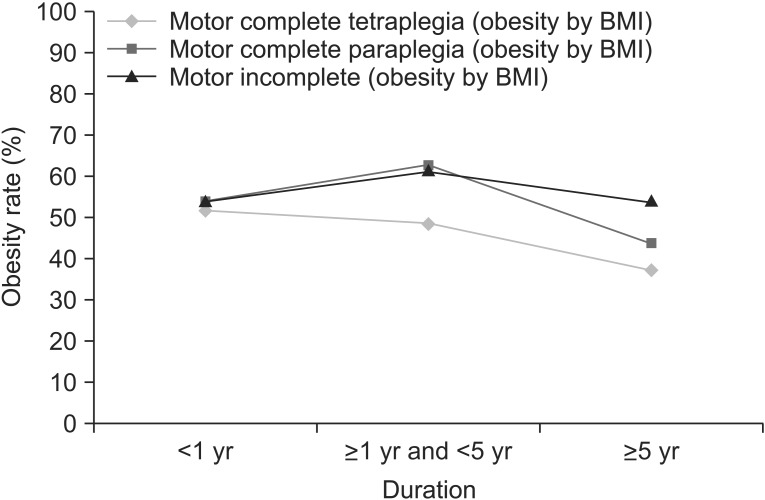Ann Rehabil Med.
2015 Jun;39(3):384-392. 10.5535/arm.2015.39.3.384.
Comparison of Fat Mass Percentage and Body Mass Index in Koreans With Spinal Cord Injury According to the Severity and Duration of Motor Paralysis
- Affiliations
-
- 1Department of Rehabilitation Medicine, National Rehabilitation Center, Seoul, Korea. ludin80@naver.com
- 2Department of Rehabilitation Medicine, Korea University College of Medicine, Seoul, Korea.
- KMID: 2165641
- DOI: http://doi.org/10.5535/arm.2015.39.3.384
Abstract
OBJECTIVE
To analyze the relationship of the change in fat mass percentage (FMP) and body mass index (BMI) with the change in obesity rate according to gender, extent of spinal cord injury (SCI) and the duration.
METHODS
The retrospective study was conducted with medical records of 915 patients. FMP was calculated with BMI and bioelectrical impedance analysis (BIA). Statistical analysis of the relationship between FMP and gender, extent of SCI and the duration after SCI was done.
RESULTS
FMP increased in relation to the duration. The mean FMP was higher in the motor complete tetraplegia group, as compared to the motor incomplete group. The rate of obesity was 69.8% with cutoff FMP values of over 22% and 35% for male and female patients, respectively. Rate of obesity was correlated with the duration after SCI and degree of paralysis. The rate of obesity was 17.1% with a cutoff value of BMI 25 kg/m2 and 51.3% with a cutoff value of 22 kg/m2. For evaluation of the diagnostic value of BMI to predict obesity according to FMP standards, a cutoff value of 25 kg/m2 showed a sensitivity level of 22.3% and specificity level of 94.9%. When the cutoff level for BMI was set at 22 kg/m2, the sensitivity and specificity were 59.3% and 67.0%, respectively.
CONCLUSION
In Korean SCI patients, FMP showed good correlation with the duration of SCI and the extent of SCI, while BMI did not. Especially in the motor complete tetraplegia group, the diagnostic value of BMI decreased as the duration after SCI increased. This study suggested that FMP could be used complementarily when evaluating the obesity of SCI patients.
MeSH Terms
Figure
Reference
-
1. Malik S, Wong ND, Franklin SS, Kamath TV, L'Italien GJ, Pio JR, et al. Impact of the metabolic syndrome on mortality from coronary heart disease, cardiovascular disease, and all causes in United States adults. Circulation. 2004; 110:1245–1250. PMID: 15326067.
Article2. Yekutiel M, Brooks ME, Ohry A, Yarom J, Carel R. The prevalence of hypertension, ischaemic heart disease and diabetes in traumatic spinal cord injured patients and amputees. Paraplegia. 1989; 27:58–62. PMID: 2784200.
Article3. Hwang J, Shon C. Relationship between socioeconomic status and type 2 diabetes: results from Korea National Health and Nutrition Examination Survey (KNHANES) 2010-2012. BMJ Open. 2014; 4:e005710.
Article4. Ohn JH, Kwon IH, Park J, Ryu OH, Lee SJ, Kim DM, et al. Unprotected daily sun exposure is differently associated with central adiposity and β-cell dysfunction by gender: the Korean National Health and Nutrition Examination Survey (KNHANES) V. Environ Res. 2014; 133:253–259. PMID: 24981823.5. Gupta N, White KT, Sandford PR. Body mass index in spinal cord injury: a retrospective study. Spinal Cord. 2006; 44:92–94. PMID: 16030513.6. Teixeira PJ, Going SB, Houtkooper LB, Cussler EC, Metcalfe LL, Blew RM, et al. Exercise motivation, eating, and body image variables as predictors of weight control. Med Sci Sports Exerc. 2006; 38:179–188. PMID: 16394972.
Article7. Gater DR Jr. Obesity after spinal cord injury. Phys Med Rehabil Clin N Am. 2007; 18:333–351. viiPMID: 17543776.8. Khalil RE, Gorgey AS, Janisko M, Dolbow DR, Moore JR, Gater DR. The role of nutrition in health status after spinal cord injury. Aging Dis. 2013; 4:14–22. PMID: 23423356.9. Wilmet E, Ismail AA, Heilporn A, Welraeds D, Bergmann P. Longitudinal study of the bone mineral content and of soft tissue composition after spinal cord section. Paraplegia. 1995; 33:674–677. PMID: 8584304.
Article10. Yarar-Fisher C, Chen Y, Jackson AB, Hunter GR. Body mass index underestimates adiposity in women with spinal cord injury. Obesity (Silver Spring). 2013; 21:1223–1225. PMID: 23913734.
Article11. Goldberg LR, Heiss CJ, Parsons SD, Foley AS, Mefferd AS, Hollinger D, et al. Hydration in older adults: the contribution of bioelectrical impedance analysis. Int J Speech Lang Pathol. 2014; 16:273–281. PMID: 24521507.
Article12. Vetrovska R, Vilikus Z, Klaschka J, Stranska Z, Svacina S, Svobodova S, et al. Does impedance measure a functional state of the body fat? Physiol Res. 2014; 63(Suppl 2):S309–S320. PMID: 24908237.
Article13. Gater DR. Pathophysiology of obesity after spinal cord injury. Top Spinal Cord Inj Rehabil. 2007; 12:20–34.
Article14. Nelson MD, Widman LM, Abresch RT, Stanhope K, Havel PJ, Styne DM, et al. Metabolic syndrome in adolescents with spinal cord dysfunction. J Spinal Cord Med. 2007; 30(Suppl 1):S127–S139. PMID: 17874698.15. Han SH, Lee SY, Kim KN, Yoo SM. Comparison between dual energy X-ray absorptiometry (DEXA) and bioelectrical impedence analysis (BIA) in measurement of lean body mass and fat mass in obese adults: based Bland-Altman plot analysis. Korean J Obes. 2006; 15:213–218.16. Pruijm M, Vollenweider P, Mooser V, Paccaud F, Preisig M, Waeber G, et al. Inflammatory markers and blood pressure: sex differences and the effect of fat mass in the CoLaus Study. J Hum Hypertens. 2013; 27:169–175. PMID: 22495106.
Article17. Mojtahedi MC, Valentine RJ, Evans EM. Body composition assessment in athletes with spinal cord injury: comparison of field methods with dual-energy X-ray absorptiometry. Spinal Cord. 2009; 47:698–704. PMID: 19290014.
Article18. Kim H, Kim CH, Kim DW, Park M, Park HS, Min SS, et al. External cross-validation of bioelectrical impedance analysis for the assessment of body composition in Korean adults. Nutr Res Pract. 2011; 5:246–252. PMID: 21779529.
Article19. Eriks-Hoogland I, Hilfiker R, Baumberger M, Balk S, Stucki G, Perret C. Clinical assessment of obesity in persons with spinal cord injury: validity of waist circumference, body mass index, and anthropometric index. J Spinal Cord Med. 2011; 34:416–422. PMID: 21903016.
Article20. Laughton GE, Buchholz AC, Martin Ginis KA, Goy RE. SHAPE SCI Research Group. Lowering body mass index cutoffs better identifies obese persons with spinal cord injury. Spinal Cord. 2009; 47:757–762. PMID: 19350042.
Article21. Spungen AM, Bauman WA, Wang J, Pierson RN Jr. Measurement of body fat in individuals with tetraplegia: a comparison of eight clinical methods. Paraplegia. 1995; 33:402–408. PMID: 7478730.
Article22. Buchholz AC, McGillivray CF, Pencharz PB. The use of bioelectric impedance analysis to measure fluid compartments in subjects with chronic paraplegia. Arch Phys Med Rehabil. 2003; 84:854–861. PMID: 12808538.23. Lohman TG, Going S. Assessment of body composition and energy balance. In : Lamb DR, Murray R, editors. Perspectives in exercise science and sports medicine. Carmel: Cooper Publishing Group;1998. p. 61–105.24. WHO Expert Consultation. Appropriate body-mass index for Asian populations and its implications for policy and intervention strategies. Lancet. 2004; 363:157–163. PMID: 14726171.25. de Groot S, Post MW, Postma K, Sluis TA, van der Woude LH. Prospective analysis of body mass index during and up to 5 years after discharge from inpatient spinal cord injury rehabilitation. J Rehabil Med. 2010; 42:922–928. PMID: 21031288.
Article26. Singh R, Rohilla RK, Saini G, Kaur K. Longitudinal study of body composition in spinal cord injury patients. Indian J Orthop. 2014; 48:168–177. PMID: 24741139.
Article27. Dearwater SR, LaPorte RE, Cauley JA, Brenes G. Assessment of physical activity in inactive populations. Med Sci Sports Exerc. 1985; 17:651–655. PMID: 4079736.
Article28. Jones LM, Legge M, Goulding A. Healthy body mass index values often underestimate body fat in men with spinal cord injury. Arch Phys Med Rehabil. 2003; 84:1068–1071. PMID: 12881836.29. Kim KD, Nam HS, Shin HI. Characteristics of abdominal obesity in persons with spinal cord injury. Ann Rehabil Med. 2013; 37:336–346. PMID: 23869331.
Article30. Modlesky CM, Bickel CS, Slade JM, Meyer RA, Cureton KJ, Dudley GA. Assessment of skeletal muscle mass in men with spinal cord injury using dual-energy X-ray absorptiometry and magnetic resonance imaging. J Appl Physiol (1985). 2004; 96:561–565. PMID: 14527962.
Article31. Bolanowski M, Nilsson BE. Assessment of human body composition using dual-energy x-ray absorptiometry and bioelectrical impedance analysis. Med Sci Monit. 2001; 7:1029–1033. PMID: 11535954.
- Full Text Links
- Actions
-
Cited
- CITED
-
- Close
- Share
- Similar articles
-
- Spinal Cord Injury
- Relationship Between Motor Evoked Potential Response and the Severity of Paralysis in Spinal Cord Injury Patients
- Correlation between body composition and spinal bone density in young women
- Association between Body Fat and Bone Mineral Density in Normal-Weight Middle-Aged Koreans
- The Association between Sleep Duration and Body Composition Variables in Korean Adults




